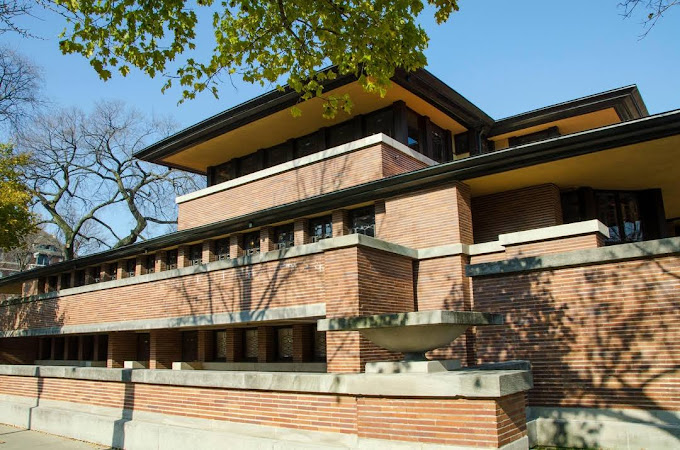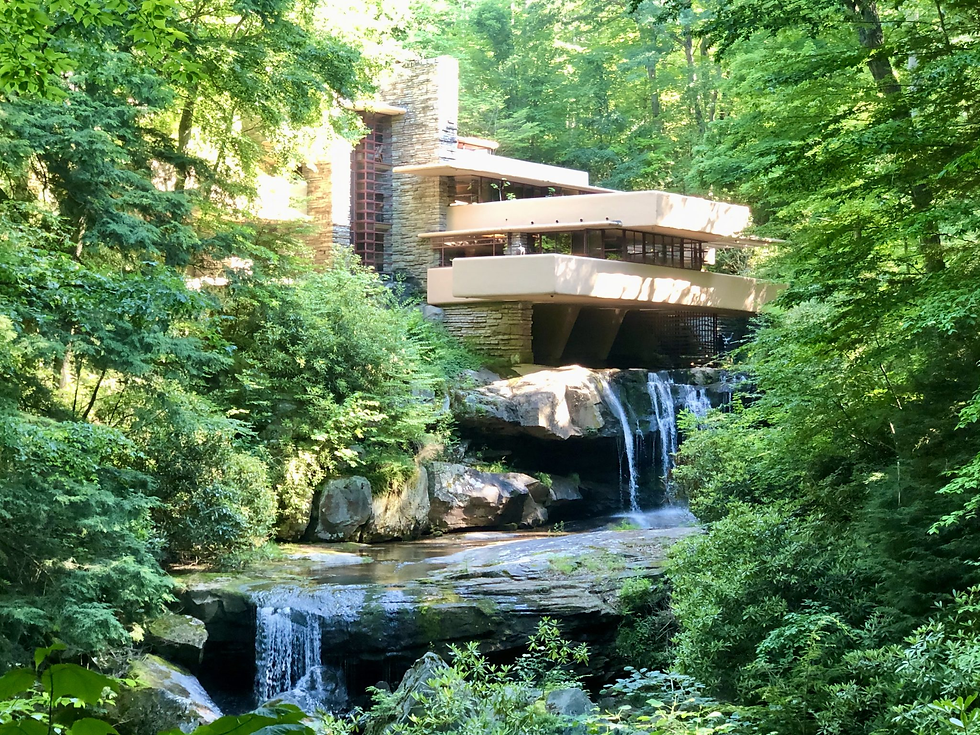Frank Lloyd Wright: A Legacy of Beauty
- Debbie Brown

- Mar 13
- 4 min read
Frank Lloyd Wright (1867–1959) remains one of the most influential architects in history, known for pioneering organic architecture—a philosophy that emphasizes harmony between human habitation and the natural world. His designs revolutionized modern architecture, and his masterpiece, Fallingwater, stands as a prime example of his vision.

Personal Life
Born in Richland Center, Wisconsin, on June 8, 1867, Wright grew up in a household shaped by his mother’s belief that he would become a great architect. His father, William Carey Wright, was a preacher and musician, while his mother, Anna Lloyd-Jones, belonged to a prominent Welsh family. Wright’s parents divorced in 1885, after which he lived with his mother.
Wright briefly studied civil engineering at the University of Wisconsin–Madison before leaving in 1887 to work in Chicago as a draftsman. His personal life was often tumultuous, including multiple marriages and relationships that garnered public scrutiny. A tragic event in 1914 at his Taliesin home—where a servant set fire to the residence and murdered Wright’s partner Mamah Borthwick and six others—marked one of the darkest moments of his life. Despite personal hardships, Wright remained devoted to his craft and continued to push the boundaries of architectural design.
Professional Life
Wright began his architectural career with the firm of Adler & Sullivan, working directly under Louis Sullivan, whom he considered a mentor. In 1893, he established his own practice, developing the "Prairie School" movement, characterized by low, horizontal lines and open interior spaces that echoed the Midwestern landscape. Notable works from this period include the Robie House in Chicago. In the 1930s, Wright introduced his vision for affordable housing through the Usonian homes, exemplified by structures like the Rosenbaum House in Alabama. His later works include the iconic Solomon R. Guggenheim Museum in New York City, showcasing his ability to blend form and function seamlessly.

Awards and Accolades
Throughout his illustrious career, Wright received numerous awards recognizing his contributions to architecture. He was honored with the Royal Institute of British Architects Gold Medal in 1941 and the American Institute of Architects Gold Medal in 1949. In 1966, several of his works, including Fallingwater, were designated as National Historic Landmarks. In 2019, eight of his buildings were collectively inscribed as a UNESCO World Heritage Site under the title "The 20th-Century Architecture of Frank Lloyd Wright."
Fallingwater
Among Wright's masterpieces, Fallingwater stands out as a testament to his philosophy of organic architecture. Designed in 1935 for the Kaufmann family, owners of a Pittsburgh department store, the house is located in the Laurel Highlands of southwestern Pennsylvania. Uniquely, Fallingwater is constructed over a waterfall on Bear Run, seamlessly integrating the natural landscape with the living space. Wright's innovative design features cantilevered terraces that extend over the waterfall, creating a harmonious blend of indoor and outdoor spaces. The use of local sandstone and the emphasis on horizontal lines mirror the surrounding rock formations and forest, embodying Wright's commitment to designing in harmony with nature.

Since opening to the public in 1964, Fallingwater has attracted millions of visitors and continues to be celebrated for its architectural brilliance. In recent years, preservation efforts have been underway to address structural issues and ensure that this iconic structure endures for future generations. The Western Pennsylvania Conservancy has been leading a comprehensive restoration project, addressing challenges such as water damage and structural integrity, with an expected completion in 2026.
Frank Lloyd Wright's legacy is evident in his transformative approach to architecture, with Fallingwater exemplifying his genius in creating spaces that exist in perfect harmony with their environment.
Works Built by or Inspired by Frank Lloyd Wright
Wright’s architectural principles have inspired numerous architects and structures worldwide. Some notable examples include:
1. John Lautner’s Space-Age Homes
Lautner, a former apprentice of Wright, carried forward the organic architecture tradition with futuristic designs like the Chemosphere House in Los Angeles.

Hollywood Hills the Garcia House by John Lautner
2. The Tokyo Imperial Hotel (Demolished 1968)
Wright designed this earthquake-resistant building in Japan (completed in 1923), influencing future seismic architectural innovations.
3. The Gammage Auditorium (1964, Arizona)
Inspired by Wright’s earlier designs, this auditorium was completed posthumously, embodying his love for circular and flowing forms.

Gammage Memorial Auditorium, ASU
4. The Marin County Civic Center (1960, California)
This government building features sweeping horizontal lines, a domed roof, and an integration with the rolling hills, following Wright’s principles.

Marin County Civic Center was Wright's final commission
5. Mid-Century Modern Architecture
Architects such as Richard Neutra and Eero Saarinen were influenced by Wright’s emphasis on open spaces, natural materials, and fluidity between indoors and outdoors.
Conclusion
Frank Lloyd Wright’s impact on architecture is immeasurable. His personal and professional journey was marked by triumph and tragedy, yet his revolutionary ideas continue to inspire architects worldwide. Fallingwater, in particular, remains a living testament to his genius, drawing visitors from around the globe.
His principles of organic architecture, the use of natural materials, and his vision of integrating buildings with their surroundings continue to shape modern architectural thought, ensuring that his legacy endures for generations to come.
References
Fallingwater. (n.d.). History of Fallingwater. Retrieved from https://fallingwater.org/history/
Fallingwater. (n.d.). What is Fallingwater?. Retrieved from https://fallingwater.org/what-is-fallingwater/
Frank Lloyd Wright Building Conservancy. (n.d.). Wright Spirit Awards. Retrieved from https://savewright.org/wright-spirit-awards/
Frank Lloyd Wright Foundation. (n.d.). About Frank Lloyd Wright. Retrieved from https://franklloydwright.org/frank-lloyd-wright/
New York Post. (2025, February 26). Frank Lloyd Wright's famed Fallingwater has a problem - with falling water. Retrieved from https://nypost.com/2025/02/26/real-estate/frank-lloyd-wrights-most-famous-creation-is-getting-a-facelift/



Comments